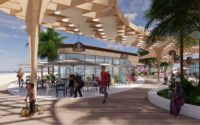How Are Waterpark Leaders In The UAE Region Stepping Up Their Sustainability Game?
The recent prolific incidents of global warming, wildfires, flooding, ice melting and intense heat waves are grave reminders that the time to act is NOW. Sustainability is the key to a better future for all.
More needs to be done to create sustainable operations across all industries. For the leisure and attractions industry, it makes perfect business sense to create environmentally friendly attractions while making them cutting-edge, entertaining and attractive to visitors. Today, an attraction which is also sustainable is highly respected by the public and can drive brand loyalty, an increase in visitors and revenue growth.
With water conservation ranking as among the top sustainability best practices for attractions, this begs the question – with water being at the heart of every waterpark, can waterparks lead the attractions industry in becoming sustainable and environmentally friendly?
In our part of the world, the MENA Waterpark Industry is known for challenging yesterday’s standards and setting new benchmarks in terms of creating the biggest and deepest iconic water attractions. Can regional water parks also set benchmarks for best practices in sustainability? We speak to the UAE Waterpark industry to know more.
What measures have WATERPARK OPERATORS been taking towards water management in a water-scarce region? How are they implementing overall sustainability in park operations and day-to-day business operations?
Chris Swartz, General Manager of Wild Wadi Waterpark and Matthew Matt Spurgeon, Director of Engineering at Wild Wadi Waterpark – the first water park in the region and a strong homegrown brand that continues to reinvent and enthral visitors – say, “In a region where water is highly valued Wild Wadi approaches this from the triple bottom line. Through our sustainability and capital programs, the executive team meets on a regular basis to discuss energy-saving strategies which involve our building management system team, so we are grounded in the reality of what can and cannot be done”.
In 2021 a program was implemented driving both electricity and water conservation. Sensors paired with Variable Frequency Drives (VFDs) changed several of the attractions from running 100% of pumping capacity for eight hours per day to only running 100% when a sensor detects the presence of a rider.
Joined by UV reactors, shell and tube heat exchangers and chemical analyzers and feeders, this system works to keep the water at the highest cleanliness standards possible. These save the amount of energy used to heat and cool the water, the chemicals in the water and the water itself. In addition to the water savings, the system used at the park removes 99.99% of microorganisms, which is on par with a drinking water system.
Kelly Timmins, Director of Conservation, Education and Corporate Social Responsibility, Atlantis Aquaventure – the world’s largest and award-winning waterpark that recently won the MENALAC Award 2022 for Best Impactful Sustainability Campaign Of The Year – says, “Atlantis Dubai launched the Atlantis Atlas Project in June 2021 – Atlantis Atlas Project is our commitment to do business in ways that are good for both people and planet. We do this by focusing on Responsible Operations, Conservation & Animal Welfare, Education & Awareness, and Corporate Social Responsibility”.
Atlantis Dubai is also dedicated to supporting the local community and donates 1 USD from every marine animal experience to projects which make measured impacts on conservation, education, and society. Atlantis Aquaventure achieved EarthCheck Silver certification for the second year running in December 2021, becoming the first waterpark in the Middle East to achieve such certification, affirming our commitment to sustainability. EarthCheck is the world’s leading scientific benchmarking, certification and business advisory group.
The Responsible Operations pillar of the Atlantis Atlas Project is a critical part of our environmental and social sustainability. We seek and implement new ways to improve our operations to reduce our environmental impacts through sourcing products and servicing responsibly, effectively managing waste, energy and reducing carbon emissions, and preserving water. We have an Environmental Management System (EMS) in place to advance and measure our progress, which helps us to mitigate any negative impacts.
We have been replacing non-native species of plants and vegetation that are not drought-tolerant with native species which require less water, thus reducing our water consumption. We have also cancelled the use of auto-irrigation systems. We have implemented a system where our gardeners carry moisture metres with them, who manually check the moisture content of the ground soil.
How are WATERPARK DESIGNERS, MANUFACTURERS AND SUPPLIERS leading the way towards making the regional water parks more sustainable?
Mike Rigby, GM & RVP, Middle East & India, WhiteWater says, “Water is a major part of the fun at a waterpark, and our team at WhiteWater recognize that it is our responsibility to ensure that this fun doesn’t risk our planet’s future. In 2020, we pledged to work across every area of our business to minimise carbon and waste impacts to ensure our products are the benchmark for sustainability in our industry. We look at how we can minimise our impact from design through to construction and installation to create products and parks to use less water, prevent water loss, and become more energy efficient.”
Water Park Landscape Design – Our architecture team uses decades of experience to create a site plan with the least environmental impact possible. This includes looking at how the ride will operate and how we can use building structures and wildlife to minimise impacts. One method is to look at the building orientation, so a park has strategic shade and windbreaks. Yas Waterworld used rockwork and grottos to minimise the direct sunlight on the pool surface and reduce evaporation. Another method the architecture team uses is adding native wildflowers to enhance biodiversity, reduce water needs, and create habitats. Enhanced landscape development can act as a carbon absorption if designed properly while increasing the park’s aesthetic.
Water Park Design to Prevent Water Loss – The sustainability work begins on day one during the architecture and design stage. Working from the ground up, the architecture team recommends materials like Life Floor which don’t heat up under the sun to help minimise water absorption. WhiteWater also uses proprietary software to perform 3D modelling and simulations of our rides to calculate how much water will be used so there is no over-specifying of the pumps and water loss is reduced and contained within the ride.
Ray Smegal, Chief Commercial Officer, ProSlide says, “We have a responsibility to ensure a vibrant and successful waterpark industry for the long term. It’s key that we think about future generations so that they can continue to enjoy waterparks in a responsible and sustainable way. ProSlide’s vision for sustainability is built upon two key pillars – sustainable manufacturing and efficient technology. When it comes to manufacturing, we’re proud to be 100% Canadian-made and have been since the beginning. This means that all ProSlide fibreglass is manufactured in a country with strong labour rights and some of the strictest emissions and chemical disposal laws in the world.
ProSlide is always visioning forward to the next waterpark technology that will transform waterparks. This includes new guest experiences as well as technologies that make waterparks more efficient and sustainable. An example is our next-generation BLAST water propulsion system for ProSlide Water Coasters. Using our experience from our hi-tech LIM propulsion, we developed BLAST which utilises multiple water nozzles in an array from the top to the bottom of the water coaster’s upward booster zones. BLAST is now the gold standard for modern water propulsion technologies and significantly reduces water flow and power. This is a great example of sustainable technologies that provide exceptional guest experiences that are good for the planet.”
Tim Sheehan, Director of Planning at Aquatic Development Group, says, “Environmental sustainability will only be adopted as standard practice when we as designers/suppliers can illustrate to clients/developers how certain relatively inexpensive supplemental initial costs can pay off financially in the long run. As a group, we need to focus better on incorporating this as standard practice when we design our parks. Our belief is that given the rising concerns about temperature rise, utility costs, and diminishing resources that all parks will have to become ‘Eco-parks’”.
In summary, waterpark designers, manufacturers and suppliers must embed sustainability at the heart of their waterpark and ride design by evaluating usage, circulation, collection and aeration of water, and also assess and reduce usage of energy in operations. They will also need to communicate on sustainable operations of their products, invest in innovation that results in conservation and energy efficiencies, and educate on ways to extend the lives of products through proper maintenance and operations to achieve sustainability in waterparks.
Will Future Waterparks be Eco parks?
Absolutely. We can already see different water and amusement parks building eco-friendly initiatives. The vision for the future is a vibrant, sustainable, and prosperous water park industry. One in which we can all enjoy the excitement, thrill, and wonder of water parks that are built and operated in a responsible and sustainable manner and become much more environmentally efficient. The good news is our global industry has the talent and expertise to make it happen.
Which region has reached the most level of sustainability in waterparks? And how can MENA waterparks reach this level?
There are regions of the world where water and energy conservation are critical due to factors like climate change. This includes Australia, California, Costa Rica, Asia, MENA and Europe, for example. Many parks are making significant improvements in their operations to be more sustainable. One of the leading sustainable parks around the world, Waterbom Bali, has zero runoff loss and composites 66% of its waste on-site, leading to fewer materials being sent to landfills.
While this goal can be intimidating, the MENA waterparks can see this as a benchmark to strive towards in the future. Even if the goal is ten years away, it is crucial waterparks do not delay in taking on the most challenging task, as they take the longest to fix and will require immediate attention. Waterbom Bali is also the first certified carbon neutral water park, with 50% of the waterpark designed to be a green space, blending the water slide towers into the natural landscape to create a lush environment that helps absorb and offset carbon.
Mr. Mishal Al Hokair, President of MENALAC (Middle East & North Africa Leisure and Attractions Council) – the regional body of the Leisure, Entertainment & Attractions Industry – says, “If we have to ensure a good future for our children and their children, sustainability is non-negotiable and must be embraced as a top priority by all industries. MENALAC for its part is doing its bit to highlight and raise awareness about the importance of sustainability in our leisure and attractions industry. In 2022 we introduced a new award category in our prestigious annual MENALAC AWARDS – THE MENALAC BEST IMPACTFUL SUSTAINABILITY CAMPAIGN OF THE YEAR AWARD 2022. We have conducted education sessions on sustainability in the leisure and attractions industry. Our Health & Safety Committee is also working on a Playbook on Sustainable Waterparks. We are committed to sustainability and will continue to highlight the importance of building sustainable attractions”.







